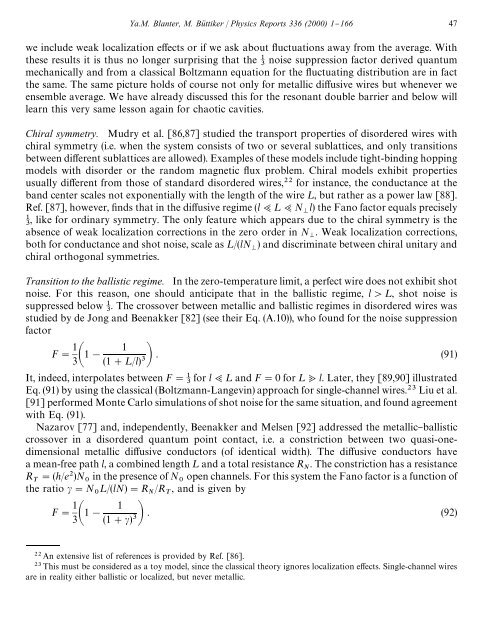shot noise in mesoscopic conductors - Low Temperature Laboratory
shot noise in mesoscopic conductors - Low Temperature Laboratory
shot noise in mesoscopic conductors - Low Temperature Laboratory
You also want an ePaper? Increase the reach of your titles
YUMPU automatically turns print PDFs into web optimized ePapers that Google loves.
we <strong>in</strong>clude weak localization e!ects or if we ask about #uctuations away from the average. With<br />
these results it is thus no longer surpris<strong>in</strong>g that the <strong>noise</strong> suppression factor derived quantum<br />
mechanically and from a classical Boltzmann equation for the #uctuat<strong>in</strong>g distribution are <strong>in</strong> fact<br />
the same. The same picture holds of course not only for metallic di!usive wires but whenever we<br />
ensemble average. We have already discussed this for the resonant double barrier and below will<br />
learn this very same lesson aga<strong>in</strong> for chaotic cavities.<br />
Chiral symmetry. Mudry et al. [86,87] studied the transport properties of disordered wires with<br />
chiral symmetry (i.e. when the system consists of two or several sublattices, and only transitions<br />
between di!erent sublattices are allowed). Examples of these models <strong>in</strong>clude tight-b<strong>in</strong>d<strong>in</strong>g hopp<strong>in</strong>g<br />
models with disorder or the random magnetic #ux problem. Chiral models exhibit properties<br />
usually di!erent from those of standard disordered wires, for <strong>in</strong>stance, the conductance at the<br />
band center scales not exponentially with the length of the wire ¸, but rather as a power law [88].<br />
Ref. [87], however, "nds that <strong>in</strong> the di!usive regime (l;¸;N l) the Fano factor equals precisely<br />
<br />
,<br />
like for ord<strong>in</strong>ary symmetry. The only feature which appears due to the chiral symmetry is the<br />
<br />
absence of weak localization corrections <strong>in</strong> the zero order <strong>in</strong> N . Weak localization corrections,<br />
<br />
both for conductance and <strong>shot</strong> <strong>noise</strong>, scale as ¸/(lN ) and discrim<strong>in</strong>ate between chiral unitary and<br />
<br />
chiral orthogonal symmetries.<br />
Transition to the ballistic regime. In the zero-temperature limit, a perfect wire does not exhibit <strong>shot</strong><br />
<strong>noise</strong>. For this reason, one should anticipate that <strong>in</strong> the ballistic regime, l'¸, <strong>shot</strong> <strong>noise</strong> is<br />
suppressed below . The crossover between metallic and ballistic regimes <strong>in</strong> disordered wires was<br />
<br />
studied by de Jong and Beenakker [82] (see their Eq. (A.10)), who found for the <strong>noise</strong> suppression<br />
factor<br />
F" 1<br />
31! 1<br />
. (91)<br />
(1#¸/l)<br />
It, <strong>in</strong>deed, <strong>in</strong>terpolates between F" for l;¸ and F"0 for ¸
















